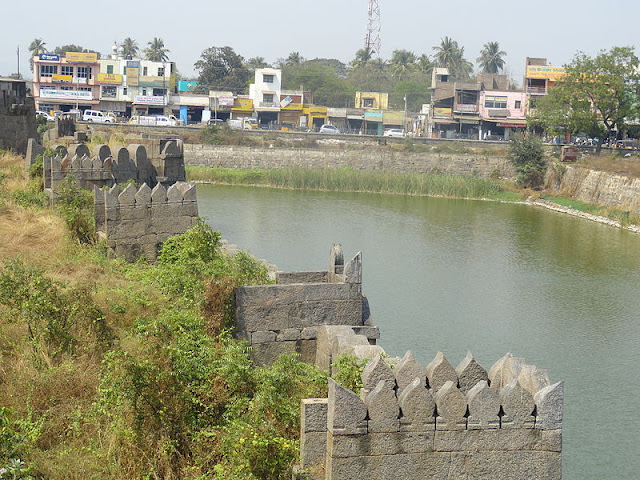Vellore Fort, Vellore
Vellore
Fort is a large 16th Century fort situated in heart of the Vellore Town, in
the state of Tamil
Nadu built by Vijayanagara kings. The fort was at one time the headquarters of the Aravidu
Dynasty of Vijayanagara Empire. The fort is known for its grand ramparts, wide moat
and robust masonry. The fort's ownership passed from Vijayanagara kings, to the Bijapur
sultans, to the Marathas, to the Carnatic Nawabs and finally to the British, who held the fort until India gained independence. Presently, Archaeological Survey of India maintains
the fort.
During
British rule, the Tipu
Sultan's family and the last king
of Sri Lanka, Sri Vikrama Rajasinha were held as
prisoners in the fort. The fort houses the Jalakandeswarar Hindu
temple, the Christian St. John's Church and a Muslim mosque, of which the Jalakandeswarar Temple is famous for its
magnificent carvings. The first significant military rebellion against British rule erupted at this fort in 1806,
and it is also a witness to the massacre of the Vijayanagara royal family
of Sriranga Raya.
History
For
brief details, please refer below link;
Fort
Complex
It is
mentioned that there is no such fort on the face of earth like the one in
Vellore. It had a deep wet ditch (moat) where once 10,000 crocodiles swarmed,
waiting to grab every intruder into this impregnable fort. It has huge double
walls with bastions projecting irregularly, where two carts can be driven
abreast. The fort was constructed in granite from the nearby quarries in Arcot and Chittoor
districts. It spreads over an area of 133 acres (0.54 km2) and is located
at an altitude of 220 m (720 ft.) within a broken mountain range.
The fort
is surrounded by a moat which was once used as an additional line of defense
in the case of an invasion. It includes an escape tunnel leading to
Virinjipuram about 12 km (7.5 mi) away, which could be used by the
king and other royals in the event of an attack, later disputed by researchers
of the ASI who found no evidence of existence of such passage. The fort is
considered to be among the best of military architecture in Southern India and
is known for its grand ramparts, wide moat and robust masonry.
The fort
houses a temple, a mosque and a church, the renowned Vellore Christian
Hospital, and many other buildings that are now used as public offices.
Jalakandeswarar Temple:
The Jalakandeswarar Temple, dedicated to Jalakandeswarar, (the original name of
the deity was Jwarakandeeswarar) is noted for its sculptures, and speaks
volumes of the exquisite craftsmanship of the highly skilled artisans of that
period. The sculpture in the porch on the left of the entrance is a masterpiece
appreciated by the connoisseurs of art and architecture. The temple was long
used as an arsenal, and remained without a deity, although several years ago it
was sanctified with an idol of Lord Shiva.
Vellore Fort Mosque:
The mosque inside the fort was constructed during the
last Arcot Nawab's period.
Presently, Muslims are not allowed to
pray inside the fort mosque.
For brief details, please refer below link;
St. John's Church:
St. John's Church, Vellore located
inside the Vellore Fort was raised in 1846 by the Government of Madras for the officers and men of the East India Company military station. The church is named after St. John the Evangelist. However, the church was never officially consecrated
and hence not officially named as St. John’s Church. St. John's Church is the
oldest standing church in the Vellore Diocese. The church was constructed during the early British
period (Robert Clive, East Indian Company).
For
brief details, please refer below link;
Tipu Sultan & Hyder Mahal:
The Tipu
Mahal and Hyder Mahal are the palaces located inside the Vellore Fort. The Tipu
Mahal has 180 rooms with a central pillar hall and the Hyder Mahal on the same
campus housed over 200 rooms.
For
brief details, please refer below link;
Government Museum:
Government
Museum is a multi-purpose museum maintained by the Department of Museum Government
of Tamil Nadu. Its treasures include ancient- and present-day curiosities
relating to subjects such as botany, anthropology, geology, numismatics, pre-history, and zoology. Historical monuments of the erstwhile composite North
Arcot district are gracefully depicted in the gallery. This museum is kept open
on all days between 9.00 a.m. and 12.30 p.m. and 2.00 p.m and 5.00 p.m. except
on holidays, and admission fee is INR 5/-.
For
brief details, please refer below link;
Royal
prisoners
Vellore
Fort has housed several royal captives over its history. After the fall
of Srirangapatnam in
1799 and the death of Tipu Sultan, his family, including his sons, daughters,
wife and mother (who was the wife of Hyder
Ali), was detained in the fort. After the 1806
Sepoy Mutiny, the British transferred
Tipu's sons and daughters to Calcutta. The tombs of Bakshi Begum (died 1806), widow of Hyder
Ali and Padshah Begum, Tipu's wife & sons, who died in 1834 are located
within a kilometer of the eastern side of the fort. Vellore Fort also became
the final destination for the last ruling monarch of Sri
Lanka, Sri Vikrama Rajasinha (1798–1815). The king and his family were kept as
prisoners of war at this fort for 17 years with his family. His grave can be
found little away from the fort along with the last raya kings of Vijayanagara
Empire.
Culture
In 1981
the Post
and Telegraph Department of India released
a stamp commemorating the fort, and in July 2006 a stamp marking the 200th
anniversary of the Mutiny was released by the Tamil
Nadu Chief
Minister.
Timings
The fort
remains open to visitors from 8 am to 8 pm in the evening on all days except
Fridays. Visitors have to purchase tickets which are sold outside the fort to
enter.
Connectivity
For
brief details, please refer below link;
























